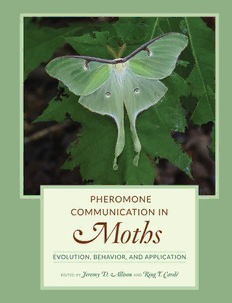
Pheromone Communication in Moths: Evolution, Behavior, and Application PDF
Preview Pheromone Communication in Moths: Evolution, Behavior, and Application
PHEROMONE COMMUNICATION IN MOTHS University of California Press, one of the most distinguished Library of Congress Cataloging-in-Publication Data university presses in the United States, enriches lives around the Names: Allison, Jeremy D., 1973- editor. | Cardé, Ring T., editor. world by advancing scholarship in the humanities, social sciences, Title: Pheromone communication in moths : evolution, behavior, and natural sciences. Its activities are supported by the UC Press and application / edited by Jeremy D. Allison and Ring T. Cardé. Foundation and by philanthropic contributions from individuals Description: Oakland, California : University of California Press and institutions. For more information, visit www.ucpress.edu. [2016] | Includes bibliographical references and index. University of California Press Identifi ers: LCCN 2016002213 (print) | LCCN 2016003460 (ebook) | Oakland, California ISBN 9780520278561 (cloth : alk. paper) | ISBN 9780520964433 (pbk.) | ISBN 9780520964433 (ebook) © 2016 by The Regents of the University of California Subjects: LCSH: Moths. | Pheromones. | Animal communication. Classifi cation: LCC QP572.P47 P437 2016 (print) | LCC QP572.P47 (ebook) | DDC 573.9/2—dc23 LC record available at http://lccn.loc.gov/2016002213 Manufactured in China 25 24 23 22 21 20 19 18 17 16 10 9 8 7 6 5 4 3 2 1 The paper used in this publication meets the minimum requirements of ANSI/NISO Z39.48-1992 (R 2002) (Permanence of Paper).∞ Cover illustration: [caption and credit]. CONTENTS LIST OF CONTRIBUTORS vii 12 Male Pheromones in Moths: Reproductive Isolation, Sexy Sons, and Good Genes / 191 PART ONE WILLIAM E. CONNER AND VIKRAM K. IYENGAR 1 Reminiscence of the Early Days / 3 PART TWO WENDELL L. ROELOFS 13 Small Ermine Moths: Role of Pheromones in 2 Pheromones: Reproductive Isolation and Evolution in Reproductive Isolation and Speciation / 211 Moths / 11 MARJORIE A. LIÉNARD AND CHRISTER LÖFSTEDT JEREMY D. ALLISON AND RING T. CARDÉ 14 Possible Reproductive Character Displacement in 3 Variation in Moth Pheromones: Causes and Saturniid Moths in the Genus Hemileuca / 225 Consequences / 25 J. STEVEN McELFRESH AND JOCELYN G. MILLAR JEREMY D. ALLISON AND RING T. CARDÉ 15 The European Corn Borer Ostrinia nubilalis: Exotic 4 Evolutionary Patterns of Pheromone Diversity in Pest and Model System to Study Pheromone Evolution Lepidoptera / 43 and Speciation / 233 CHRISTER LÖFSTEDT, NIKLAS WAHLBERG, AND JEAN-MARC LASSANCE JOCELYN G. MILLAR 16 Divergence of the Sex Pheromone Systems in 5 Sexual Selection / 79 “Oriental” Ostrinia species / 245 MICHAEL D. GREENFIELD JUN TABATA AND YUKIO ISHIKAWA 6 Genetic Control of Moth Sex Pheromone Signal and 17 Utetheisa ornatrix (Erebidae, Arctiinae): A Case Study Response / 89 of Sexual Selection / 259 KENNETH F. HAYNES VIKRAM K. IYENGAR AND WILLIAM E. CONNER 7 Contextual Modulation of Moth Pheromone Perception 18 Pheromone Communication, Behavior, and by Plant Odors / 101 Ecology in the North American Choristoneura TEUN DEKKER AND ROMINA B. BARROZO genus / 265 8 Toward a Quantitative Paradigm for Sex Pheromone PETER J. SILK AND ELDON S. EVELEIGH Production in Moths / 113 19 The Endemic New Zealand Genera Ctenopseustis STEPHEN P. FOSTER and Planotortrix: A Down-Under Story of 9 Molecular Biology of Reception / 127 Leafroller Moth Sex Pheromone Evolution and WALTER S. LEAL Speciation / 277 10 Moth Sex Pheromone Olfaction: Flux and Flexibility in RICHARD D. NEWCOMB, BERND STEINWENDER, JÉRÔME the Coordinated Confl uences of Visual and Olfactory ALBRE, AND STEPHEN P. FOSTER Pathways / 139 20 Evolution of Reproductive Isolation of Spodoptera THOMAS C. BAKER AND BILL S. HANSSON frugiperda / 291 11 Moth Navigation along Pheromone Plumes / 173 ASTRID T. GROOT, MELANIE UNBEHEND, SABINE HÄNNIGER, MARÍA LAURA JUÁREZ, SILVIA KOST, AND DAVID G. HECKEL RING T. CARDÉ 21 Pheromones of Heliothine Moths / 301 24 Mating Disruption of Moth Pests in Integrated Pest N. KIRK HILLIER AND THOMAS C. BAKER Management: A Mechanistic Approach / 365 MAYA EVENDEN PART THREE INDEX 395 22 Monitoring for Surveillance and Management / 337 D. M. SUCKLING 23 Pheromones as Management Tools: Mass Trapping and Lure-and-Kill / 349 ALAN CORK LIST OF CONTRIBUTORS jérôme albre The New Zealand Institute for Plant & Food yukio ishikawa The University of Tokyo, Japan Research, New Zealand vikram k. iyengar Villanova University jeremy d. allison Canadian Forest Service, Canada maría laura juárez Estación Experimental Agroindustrial thomas c. baker Pennsylvania State University Obispo Colombres, Argentina romina b. barrozo University of Buenos Aires, silvia kost Max Planck Institute for Chemical Ecology, Argentina Germany ring t. cardé University of California, Riverside walter s. leal University of California, Davis william e. conner Wake Forest University marjorie a. liénard Lund University, Sweden alan cork University of Greenwich, United Kingdom christer löfstedt Lund University, Sweden teun dekker Swedish University of Agricultural Sciences, jean-marc lassance Harvard University Sweden j. steven mcelfresh University of California, Riverside eldon s. eveleigh Canadian Forest Service Fredericton, jocelyn g. millar University of California, Riverside Canada richard d. newcomb The New Zealand Institute for Plant maya evenden University of Alberta, Canada & Food Research, New Zealand stephen p. foster North Dakota State University wendell l. roelofs New York State Agricultural michael d. greenfi eld Université François Rabelais Experiment Station deTours, France peter j. silk Canadian Forest Service Fredericton, astrid t. groot University of Amsterdam, The Canada Netherlands bernd steinwender The New Zealand Institute for Plant sabine hänniger Max Planck Institute for Chemical & Food Research, New Zealand Ecology, Germany d.m. suckling The New Zealand Institute for Plant & Food bill s. hansson Max Planck Institute for Chemical Research, New Zealand Ecology, Germany jun tabata National Institute for Agro-Environmental kenneth f. haynes University of Kentucky Sciences, Japan david g. heckel Max Planck Institute for Chemical melanie unbehend Max Planck Institute for Chemical Ecology, Germany Ecology, Germany n. kirk hillier Acadia University, Canada niklas wahlberg University of Turku, Finland vii PART ONE
